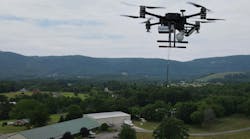New Avionics Corp. in Fort Lauderdale, Fla., announced the availability of an unmanned aerial vehicle (UAV) sensor for detecting ice made entirely of plastic. The Model 9732-UAV ice-detecting transducer probe solves the problem of conductive metallic interference with mission-critical radio antennas on UAVs and other small aircraft. The sensor body for this piece of unmanned vehicle electronics consists of Delrin and Acrylic plastics. The only metal in this addition to UAV sensors is in the wire to connect it to its host system. This family of UAV payloads is transparent to radio frequencies. The elimination of all metal parts was the primary objective in the sensor’s development. All prior existing features and benefits of the original Model 9732-OEM optical sensor, fabricated of type 316L marine-grade stainless steel, are retained in the new plastic Model 9732-UAV. RF transparency and the elimination of all metal parts are necessitated by a requirement to locate and install the sensor in close proximity to mission-critical GPS and other types of radio antennas. Model 9732-UAV can be installed virtually anywhere on an aircraft fuselage, at any angle of attack, raked forward or aft, and any orientation of the sensor air gap. The only requirement is that the air gap be located beyond the airflow boundary layer, company officials say. The sensor measures 1.5 inches long by .25 inch diameter and weighs less than 10 grams. It features an ice detection threshold of 0.001 inch of ice or better. This sensitivity immediately alerts UAV operators and pilots to the aircraft’s presence in an icing domain, and allows them to take early corrective action, long before ice builds to become any kind of hazard to aircraft in flight, New Avionics officials say. Model 9732-UAV provides common 5/16-inch-24 mounting threads, and an attachment flange that accommodates any ordinary 7/16-inch open-end wrench. The length of the connection link from the base of the sensor probe to the host electrical system is user-defined, and can be specified anywhere from an inch to several feet. For more information, visit New Avionics Corp. online at www.newavionics.com.
Voice your opinion!
Voice your opinion!


